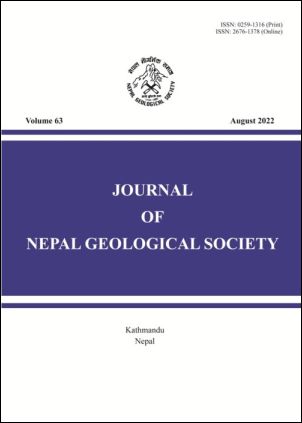Lithostratigraphy and metamorphism of the Khudi-Tal area, west central Nepal
DOI:
https://doi.org/10.3126/jngs.v63i01.50844Keywords:
Lithostratigraphy, poly-phase metamorphism, MCT, Khudi-Tal area, west-central NepalAbstract
The study is mainly focused on lithostratigraphy, petrography and geological structures to decipher the metamorphic facies and metamorphic history of the Khudi-Tal area along the Marsyangdi Valley, west central Nepal. Geological mapping was carried out covering 142 sq.km, on the scale of 1:50000. The Main Central Thrust (MCT) separates lithological succession of the Lesser Himalaya and Higher Himalaya around Bahundanda, Probhi and Naiche of the Khudi-Tal area. Lithological succession is dominated by metapelitic to psammatic schist, siliceous to dolomitic marble, quartzites, graphitic to garnet schist, kyanite garnet gneiss and banded gneiss from south to north. The kyanite isograd follow the MCT separating Kyanite zone with mineral assemblages Ky+Grt+Qtz+Ms+Bt+Pl of the Higher Himalaya and Garnet zone as Grt+Bt+Ms+Chl+K-Fel+Pl+Qtz in pelitic rocks, Bt+Ms+Chl+Plag+Qtz in Psammatic rocks and Cal/ Dol+Qtz+Pl+Bt+Ms in calcareous rock of the Lesser Himalaya. Based on the mineral assemblages, the Higher Himalaya belongs to Amphibolite Facies whereas the Lesser Himalaya belongs to Epidote-Amphibolite Facies. The lithological succession of the Higher and the Lesser Himalaya has undergone poly-phase metamorphism. In the Lesser Himalayan zone rocks, the regional burial metamorphism M1 (pre-MCT/ eo-Himalayan) is followed by barrovian type garnet grade inverted metamorphism M2 and later post-MCT retrogressive metamorphism M3. In the Higher Himalaya rocks, the early phase kyanite bearing medium temperature/ high pressure regional prograde metamorphism M1 (pre-MCT/ eo-Himalayan) is followed by barrovian type inverted metamorphism M3 (syn-MCT/ neo-Himalayan) and over printed by later phase retrogressive metamorphism M3 (post-MCT).
Downloads
Downloads
Published
How to Cite
Issue
Section
License
© Nepal Geological Society




